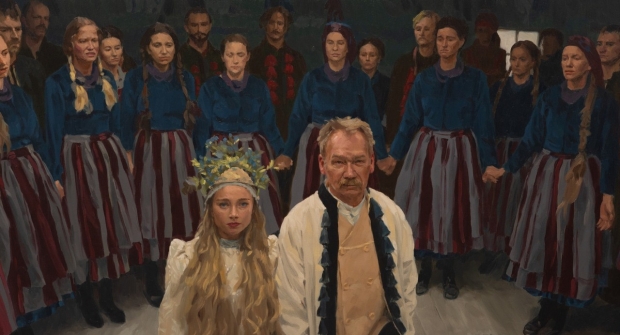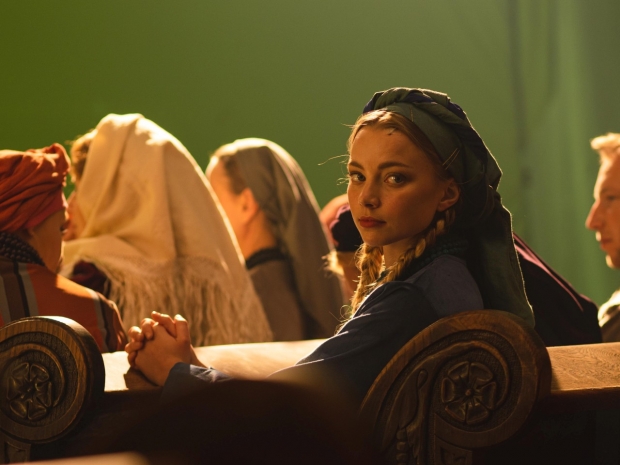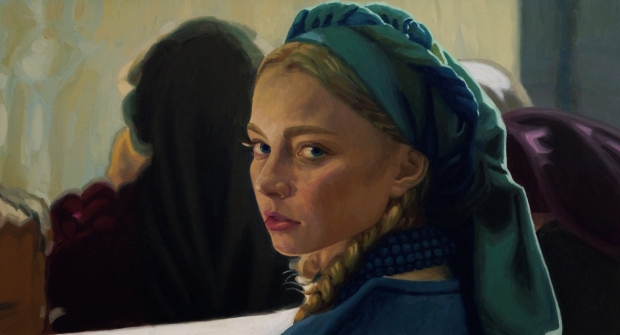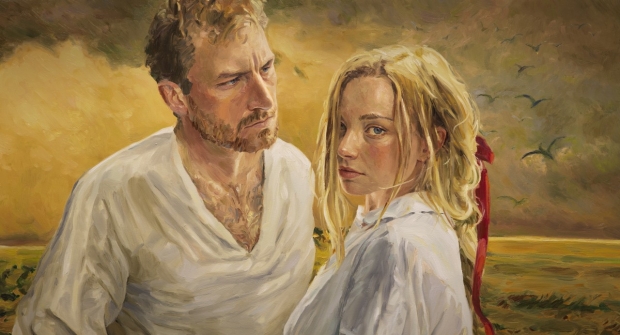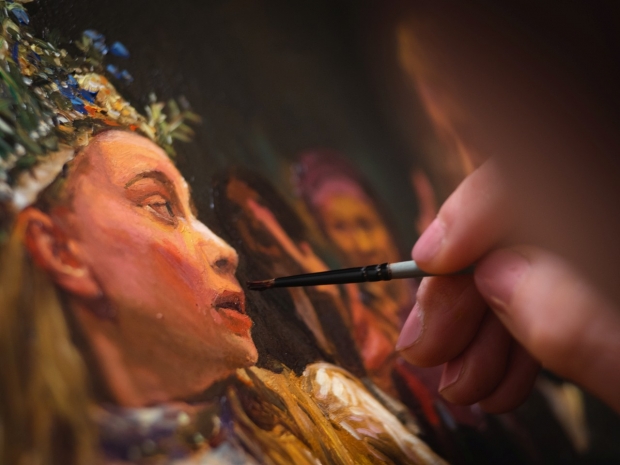The team behind 2017’s Oscar-nominated ‘Loving Vincent’ returns with a vibrant new oil painted and rotoscoped animated feature about a young woman, Jagna, whose determination to forge her own path puts her on a tragic collision course with her 19th century Polish village community, opening in U.S. theaters on January 26, 2024.
After the success of their Oscar-nominated biographical drama Loving Vincent in 2017, the world’s first fully painted animated feature – 65,000 frames in all - filmmaking couple DK Welchman and Hugh Welchman were invigorated to embark on their next ambitious, oil-painted and rotoscoped project, The Peasants, Poland’s official selection for Best International Feature at this 2024 Academy Awards, which releases in U.S. theaters Friday, January 26. Enlisting a group of over 100 painters from Serbia, Ukraine, and Lithuania, as well as their home in Poland, the team began work in 2018 on their adaptation of the Nobel Prize-winning turn-of-the-century novel of the same name by writer Władysław Reymont.
But COVID shut down production of DK and Hugh’s live-action shoots, not once, but twice. And then came Russia’s 2022 war with Ukraine, which shut down painting for a year. Hugh described the project as being “mired with conflict,” he and DK never knowing if the film would survive another month. That is, until their painters from Ukraine changed the tone of production.
“When the war broke out, we immediately bought tickets for all of our painters in Kyiv to come to Poland,” says Hugh. “They arrived at the border, some of them came with their kids, others came with elderly parents, and we found them houses and schools. Their husbands and fathers weren't allowed to leave, and their houses were being bombed. You would think, as refugees, they would be depressed. But when they got settled into our studio, this group of women brought a whole new level of positivity to the project. They were so excited to work and paint. Meanwhile, the rest of us were so miserable about COVID and the 20 percent inflation in Poland. But these women from Ukraine were facing maximum uncertainty and were still like, ‘We can do this.’ That turned the project around, and we became a team again.”
The Peasants, an animated, immersive new film from Sony Pictures Classics that’s written and directed by DK and Hugh, tells the story of Jagna, a young woman determined to forge her own path within the confines of a late 19th century Polish village – a hotbed of gossip and on-going feuds, held together, rich and poor, by pride in their land, adherence to colorful traditions, and a deep-rooted patriarchy. When Jagna finds herself caught between the conflicting desires of the village’s richest farmer, his eldest son, and other leading men of the community, her resistance puts her on a tragic collision course with the community around her.
So, it’s all too fitting that this film – produced by BreakThru Films, DigitalKraft, and Art Shot – would be fueled by the unrelenting passion of women refugees. And its challenge of patriarchy also is rather poignant.
“One of our aims with this adaptation is to have some justice for Jagna,” notes Hugh. “In schools, it is taught that Jagna’s a slut and that she's immoral. I hope that what comes across in our film is that Jagna is not to blame, and it's completely unfair what society does to her. When the film first came out in Polish theaters in October, much of the audience was teenagers and people in their early 20s. And a lot of the women, of all ages, came up to us and said, ‘We're so glad you gave Jagna a voice.’”
Reymont’s “The Peasants” is split into four parts – Autumn (published in 1904), Winter (published in 1904), Spring (published in 1906), and Summer (published in 1909) – with Autumn being required reading for Polish high school students. But when DK read the book as a high school student herself, it didn’t initially strike her as something she’d like to work on in her future filmmaking career.
“It's hard to be struck by this book when you’re 17 because it has insanely long descriptions of nature and things that are not that easy to follow for the teenage brain when you don't have that much patience,” says DK. “But I was moved by Jagna. She was a character who was defying the rules of this liberal society in a kind of quiet rebellion. For example, after you get married, it’s a tradition that you have to cut your hair short, and Jagna wouldn't agree to that. Even though she couldn't rebel against marrying Boryna, she could rebel in other ways.
She continues, “But what was also interesting for me with this character is how many double standards are related to her in this novel. She's blamed for everything. Men are never blamed and are even praised for those same things. That was something I related to in my life. And it happened to me several times. There are also some darker things that I remember from when I was in my early youth that happened to be similar.”
DK re-read the book while working on Loving Vincent, listening to the audiobooks as she worked on the film’s paintings. That’s the moment, she says, when she fully realized how well suited this film would be to the painterly style she and Hugh had been honing on Loving Vincent. DK seized the opportunity to tell the story of her beloved Jagna and take her and Hugh’s rotoscoping techniques to a new level.
“There are these beautiful descriptions of the seasons changing, and it’s like nothing I’ve ever read,” says Hugh, who read the book for the first time after DK spent a long time locating English copies that had been out of print since 1943. “I was actually disappointed when I went to the real place that the author describes because it's rather flat and featureless. But when you read the novel, it’s so intensely poetic and beautiful. And the descriptions of the weather, the descriptions of the characters - everything's mystical, which is why we felt that it was very appropriate for oil painting animation. When you read, what comes into your head is more like a painting than it is like real life, but, at the same time, the characters, and emotions, feel very real.”
Unlike other rotoscoping methods, Hugh and DK don’t trace over their live-action shots. Instead, the team’s painters create oil paintings based on the live shots, which then become frames in the film. The Peasants is painted at 6 frames per second, rather than 12 frames per second like in Loving Vincent, and the in-between frames are created with a team of digital artists.
“Initially, we thought we might be able to automate the in-between frames using AI,” shares Hugh. “We did six months of trials, and it was a disaster, which is how we ended up with hundreds of digital artists working in Photoshop and After Effects.
Also, unlike Loving Vincent, where the average frame of painting took two and a half hours, the average frame of painting for The Peasants’ realist style took five hours. In the end, the film used 42,000 total oil paintings by painters around the world. DK says those from Ukraine working in the Polish studios were pulling more than a few all-nighters.
“I treasure my sleep, so I would never ask someone to sacrifice theirs,” she says. “But they were just so eager to work and would be painting into all hours to make sure this film got done.”
While most of Loving Vincent’s sequences are static and mainly consist of interviews with a few people, The Peasants is all about movements, often in large groups. It’s another reason why the paintings took so much longer to complete.
“Because of the very violent emotions and violent passions, we felt it was important to be inside the dances with Jagna, inside the fights and the hand-to-hand combat,” says Hugh. “But the scale was huge. We've got big weddings, battles with 60 combatants and 12 horses, lynchings, and dynamic dance scenes. And we couldn't do all the shooting in the studio. So, 10 percent of the film is shot outside. There was actually a winter scene we shot in a forest with white sand because we couldn’t afford snow.”
The team also used cardboard sets for the film, since the images were going to be freshly painted anyway.
“We had a Lego kit of cardboard boxes to create all the different venues,” notes Hugh. “It was much cheaper, much more environmentally friendly, and it was much faster to change the sets.”
Time was of the essence, and the crew had to move quickly, but meticulously. In the end, it took five years to complete The Peasants, just two years short of the time it took Reymont to complete the four-part novel, the writing of which was also delayed due to railway accidents and the author’s own health issues.
Hugh and DK have been pleased by their film’s reception in Poland. While in theaters, the film received 1.75 million admissions as well as the Special Jury Prize, Audience Award, and Crystal Star Elle Award at the Polish Film Festival. The couple is hoping their film will also find an audience outside of Poland.
“DK was worried that maybe it wasn't a relevant story outside of Poland, but the characters, the conflicts, the family, the family feuds, all reminded me of my childhood growing up in British villages in the 1980s,” says Hugh. “It’s become a hot topic in Poland with people doing flash dances and dressing up as Jagna. It’s created this Peasant mania in Poland but we're hoping we can replicate that in other places too, like America.”


